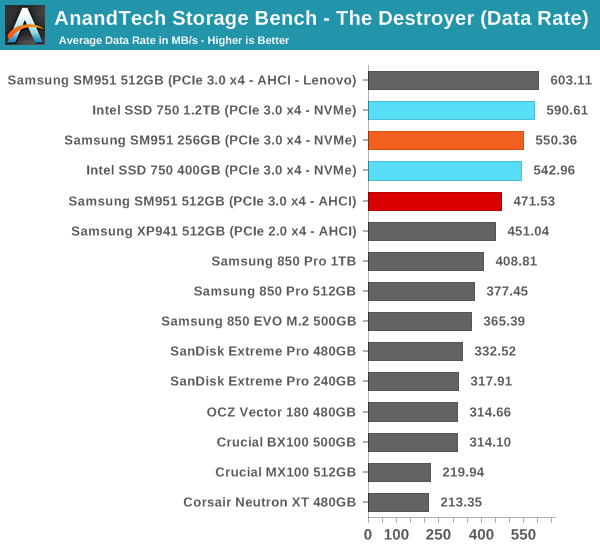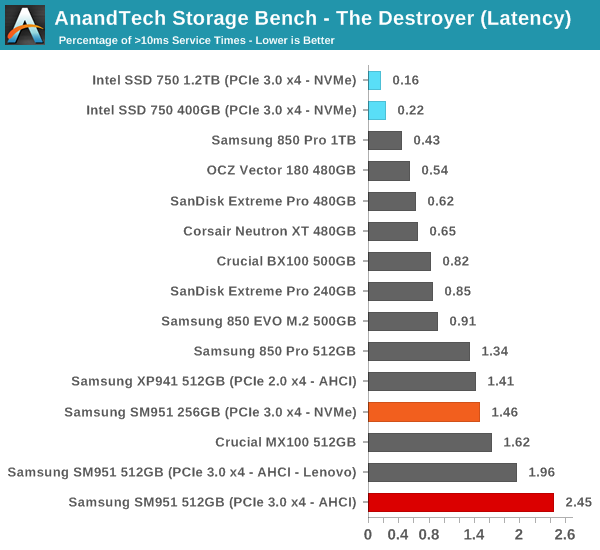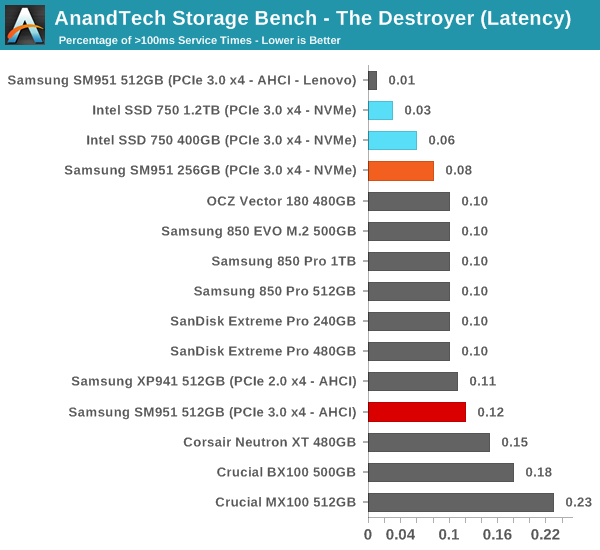Samsung SM951-NVMe (256GB) PCIe SSD Review
by Kristian Vättö on June 25, 2015 9:40 AM ESTAnandTech Storage Bench - The Destroyer
The Destroyer has been an essential part of our SSD test suite for nearly two years now. It was crafted to provide a benchmark for very IO intensive workloads, which is where you most often notice the difference between drives. It's not necessarily the most relevant test to an average user, but for anyone with a heavier IO workload The Destroyer should do a good job at characterizing performance. For full details of this test, please refer to this article.

In our The Destroyer trace, the SM951 NVMe is faster than the AHCI version despite having only half the NAND, but it still gets beaten by the SSD 750 (although the SSD 750 has more NAND as well). As I mentioned in the review, the SSD 750 has excellent small IO performance under intensive IO loads, resulting in much lower latency than what the SM951 offers, but since it performs more poorly with sequential IOs the average data rate is equivalent to the SM951 NVMe. What's surprising, though, is the fact that the SM951 AHCI that was pulled from the Lenovo laptop is in fact considerably faster than the stock SM951 we received straight from Samsung. I even ran the trace twice the ensure that it's not a benchmark anomaly, but maybe there is something wrong with my sample given that even the XP941 and several SATA 6Gbps drives outperform it.

The SM951 NVMe also has a higher share of high latency IOs than the SSD 750, but that's quite typical to smaller capacity Samsung drives.












74 Comments
View All Comments
patrickjp93 - Thursday, June 25, 2015 - link
They aren't all storage transfer commands go through the PCH. Your PCIe SSDs do not connect to the CPU directly in most cases. Some enterprise grade drives do, but most consumer do not.Kristian Vättö - Friday, June 26, 2015 - link
PCIe is PCIe regardless of whether the controller is inside the CPU or PCH. PCH merely acts as a hub for different interfaces, but ultimately it connects to the CPU as well since that is where all the processing is done.CajunArson - Thursday, June 25, 2015 - link
Yeah so are we missing some sound and FURY [hint hint] about this SSD on a stick?Kristian Vättö - Thursday, June 25, 2015 - link
Fury X is coming, Ryan just needed one more day because the flu has been undermining his ability to work.DigitalFreak - Thursday, June 25, 2015 - link
(hint hint) The 980ti is faster than the Fury X all around.CajunArson - Thursday, June 25, 2015 - link
I'm not disagreeing with that statement.I just want the review.
lilmoe - Thursday, June 25, 2015 - link
+1A DX12 showdown between FuryX and 980ti would be highly welcome as well.
Gigaplex - Thursday, June 25, 2015 - link
The Fury X wins in some of the 4k tests. The 980Ti seems faster overall, but it's not "all around".mr_tawan - Friday, June 26, 2015 - link
From what I've read, it looks like the Fury has advantages when it comes to memory-intensive use case.SofS - Thursday, June 25, 2015 - link
About the driver issue, how do different operating systems fare? Like 32/64 bits, XP/7/8/10 and Linux old/new (for instance CentOS/Fedora).